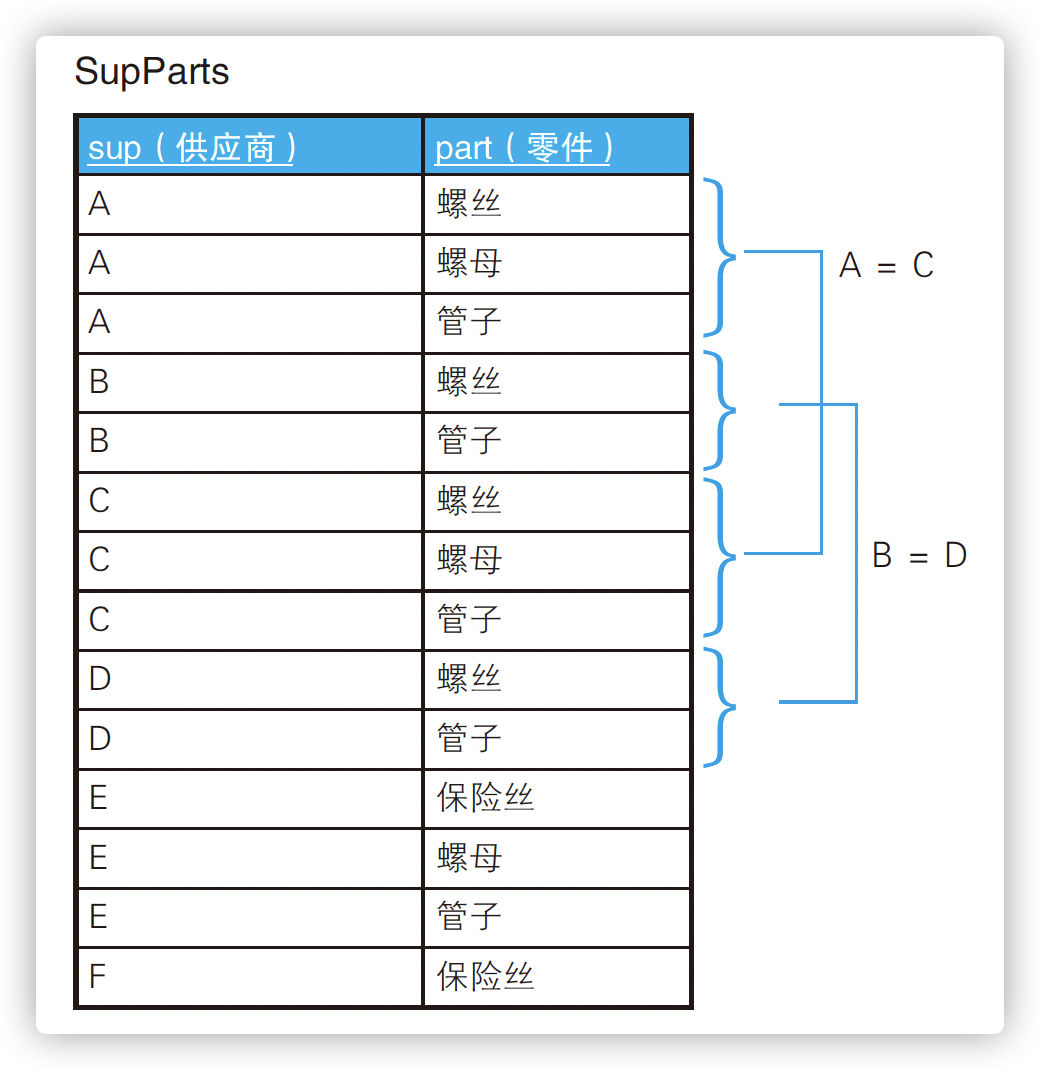SQL07 set calculation
Relational Division
Define table R and table S as follows
R
| X | Y |
|---|---|
| X1 | Y1 |
| X2 | Y2 |
| X2 | Y3 |
| X2 | Y3 |
| X3 | Y1 |
| X3 | Y2 |
S
| Y | F |
|---|---|
| Y1 | F1 |
| Y2 | F2 |
For relationships (tables) with the same attributes, R and S relationship division is mainly divided into the following steps:
1. Find the same attribute y. Project y in relation R, that is, take out the value of Y
Y->{Y1, Y2}
2. The attribute column in the divided relation R that is different from that in S is x, and the relation R does the projection (de duplication) X1 and X2 of the de duplicated value on the attribute X
3. Obtain the image set corresponding to X attribute in relation R,
X1->{ Y1}
X2->{Y1 ,Y2, Y3}
X3->{ Y1, Y2}
4.R div S is to see whether the image set corresponding to the X attribute in R contains all the values of Y, which can be divided into the following three cases:
| Divisor | Divisor | merchant | remainder | meaning | |
|---|---|---|---|---|---|
| to be divisible by | X3 | Y | n | {} | Table R contains exactly the X of all Y |
| Division with remainder | X2 | Y | n | {Y3} | Table R contains the X of all Y |
| The divisor set is not contained by the divisor | X1 | Y | 0 | {} | Table R does not contain all Y's X's |
Here's how to implement SQL:

As shown in the figure above, select employees who are proficient in Skills from EmpSkills
The above problem can be converted into that the difference set of the elements in the skill table minus the employee's personal technology stack is empty. The SQL is as follows:
SELECT DISTINCT emp
FROM EmpSkills es1
WHERE NOT EXISTS
(
SELECT * FROM Skills
EXCEPT
SELECT * FROM EmpSkills es2
WHERE es1.emp=es2.emp
)
Since not all SQL engines support excel operation, we use NOT EXISTS to implement it.
SELECT DISTINCT emp
FROM EmpSkills es1
WHERE NOT EXISTS
(
SELECT * FROM Skills s1
WHERE NOT EXISTS
(
SELECT * FROM EmpSkills es2
WHERE es2.emp=es1.emp AND es2.skill=s1.skill
)
)
In addition, it can also be implemented with the HAVING clause
SELECT es.emp FROM EmpSkills es, Skills s WHERE es.skill=s.skill GROUP BY es.emp HAVING COUNT(es.skill)=SELECT COUNT(skill) FROM Skills
The above SQL first finds the intersection of the two tables Skill, and then checks whether the quantity is consistent with the quantity in the Skill table.
Then let's take an advanced step, that is, select employees who are just proficient in Skills from EmpSkills, no more or less, that is, accurate division.
SELECT DISTINCT emp
FROM EmpSkills es1
WHERE NOT EXISTS
(
SELECT * FROM Skills s1
WHERE NOT EXISTS
(
SELECT * FROM EmpSkills es2
WHERE es2.emp=es1.emp AND es2.skill=s1.skill
)
)
AND NOT EXISTS
(
SELECT * FROM EmpSkills es2
WHERE NOT EXISTS
(
SELECT * FROM Skills s1
WHERE es2.emp=es1.emp AND es2.skill=s1.skill
)
)
In addition to the NOT EXISTS implementation, let's also look at the implementation with the HAVING clause. We use external connections to complete this operation
SELECT es.emp
FROM EmpSkills es
LEFT OUTER JOIN Skills s
ON es.skill=s.skill
GROUP BY es.emp
HAVING COUNT(es.skill)=SELECT COUNT(skill) FROM Skills
AND COUNT(s.skill)=SELECT COUNT(skill) FROM Skills
UNION operator
This section mainly explains UNION operation through an example
How to judge whether two tables are equal
Method for judging whether two tables are equal
A
∪
B
=
A
∩
B
=
A
=
B
A \cup B=A \cap B=A=B
A∪B=A∩B=A=B
Equivalent to
C
O
U
N
T
(
A
∪
B
)
=
C
O
U
N
T
(
A
)
=
C
O
U
N
T
(
B
)
COUNT(A \cup B)=COUNT(A)=COUNT(B)
COUNT(A∪B)=COUNT(A)=COUNT(B)
Find equal subsets
Look for suppliers with exactly the same type and quantity of parts

SELECT
FROM SupParts sp1,
SupParts sp2
WHERE sp1.sup>sp2.sup
AND sp1.part=sp2.part
GROUP BY sp1.sup,
sp2.sup
HAVING COUNT(*)=(
SELECT COUNT(*)
FROM SupParts sp3
WHERE sp1.sup=sp3.sup
)
AND (
SELECT COUNT(*)
FROM SupParts sp4
WHERE sp2.sup=sp4.sup
)